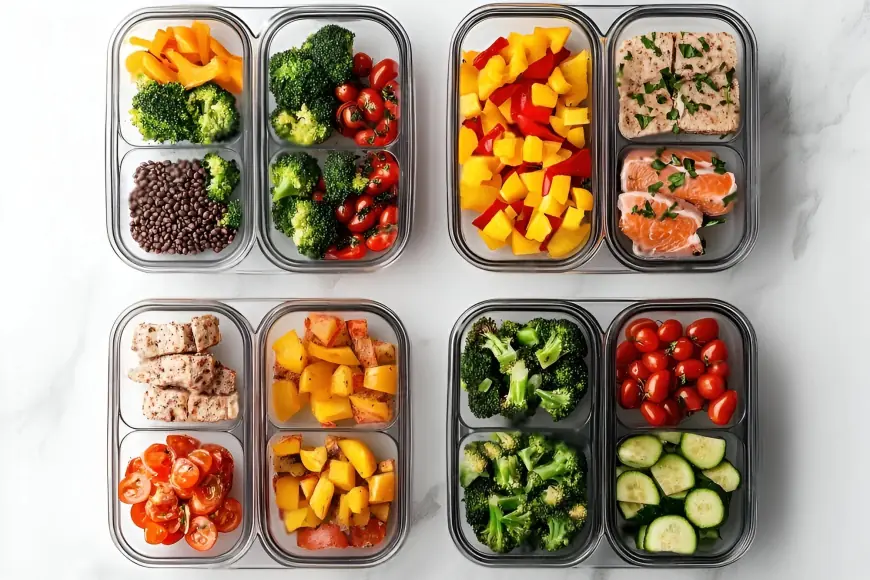The Best High-Protein Plant-Based Foods for Busy Professionals
A plant-based protein diet can benefit busy lives

For today’s fast-paced professionals, energy, focus, and sustained well-being are essential. But with tight schedules, finding time to prepare nutrient-rich meals can be difficult. Fortunately, adopting a plant-based diet, especially one rich in high-quality protein, doesn’t need to be complicated or time-consuming.
This guide explores practical and delicious plant protein sources and ways to create a high-protein meal plan that fits a hectic lifestyle. It does this through scientific nutrition and contemporary meal planners.
Why Choose a Plant-Based, High-Protein Diet?
A plant-based protein diet can benefit busy lives:
-
Steady energy and focus: Plant-based foods supply fiber, antioxidants, and steady-releasing carbs alongside protein for consistent fuel throughout the day.
-
Heart and metabolic health: Plant proteins are linked with a lower risk of heart disease, certain cancers, and diabetes.
-
Weight management: Fiber and complex carbs help maintain satiety, avoiding energy slumps and snacking pitfalls.
-
Environmental perks: Choosing plant-based meals supports sustainability by reducing your carbon footprint.
Top Plant-Based Protein Foods
1. Legumes
Lentils, chickpeas, and beans top the list of plant-based foods high in protein, with lentils offering up to 18g per cooked cup and beans about 15g. Their fiber aids digestion, keeps you full, and stabilizes blood sugar.
-
How to use: Add to salads, wraps, soups, or grain bowls for a quick source of protein.
2. Soy-Based Foods
Tofu and chickpeas are the true cornerstones of a plant-based protein meal. A 100g serving provides approximately 12-20 grams of complete protein (all essential amino acids).
-
How to use: Stir-fry with veggies, add to noodle dishes, or cube for power bowls.
3. Whole Grains
Quinoa, Buckwheat, rice, and cereal grains boast more protein than conventional grains and are quick to prepare. Quinoa, for example, delivers about 8g of protein per cup, with a full spectrum of amino acids.
-
How to use: Make grain salads, morning meals, or hearty sides.
4. Nuts and Seeds

Hemp, chia, pumpkin, and sunflower seeds, plus almonds, peanuts, and walnuts, provide protein, healthy fats, and micronutrients. The protein content of hemp seeds is approximately 10 grams per tablespoon.
-
How to use: Sprinkle on oatmeal, blend into smoothies, or add to energy bars.
5. Seitan
Known as “wheat meat,” this product contains approximately 25g of protein per 100g, making it a powerhouse for those seeking a dense, meat-like texture.
-
How to use: Grill, sauté, or roast with veggies; stuff into sandwiches for portable protein.
Building a High-Protein Plant-Based Meal Plan
Breakfast
-
Savory tofu scrambled with spinach and peppers.
-
Smoothie blended with soymilk, almond butter, and hemp seeds.
Lunch
-
Lentil or chickpea salad: Add roasted veggies, leafy greens, and quinoa.
-
A bean chili is a quick and filling dish that keeps well in the refrigerator.
-
Hummus and whole-grain wraps stuffed with shredded carrots, sprouts, and tempeh.
Snacks
-
Roasted chickpeas
-
Homemade trail mix (nuts, seeds, dried fruit)
-
Nut butter on whole-grain toast
-
Energy balls (dates, nuts, seeds).
Dinner
-
Brown rice, broccoli, and snap peas stir-fried with tofu or tempeh.
-
Chickpea rotini with grilled vegetables and pesto.
-
Bowls of grains, beans, seeds, and mixed vegetables.
Tips to Succeed on a Plant-Based Protein Diet
-
Prep in advance: Batch cook legumes and grains to save time.
-
Mix up your proteins: Variety ensures optimal nutrition, as different sources provide different amino acids.
-
Embrace convenience: Healthy delivery options or meal kits can make sticking with a plant-based diet meal plan easy for busy schedules.
-
Look for double-duty meals: Power bowls, hearty salads, and wraps can double as lunch or dinner.
Health and Performance Benefits
Busy professionals often worry about protein intake without meat. However, research confirms that, with thoughtful choices, a high-protein meal plan rich in plant foods is both achievable and beneficial.
-
Muscle maintenance and growth: Properly balanced plant-based protein meals support muscle health like animal proteins.
-
A healthy diet should include fiber and protein to maintain steady energy levels and control cravings.
-
Vitamins and antioxidants: Plant proteins are packed with nutrients for the brain, heart, and immune health.
Sample One-Day High-Protein Plant-Based Meal Plan
|
Meal |
Example |
Protein Estimate |
|
Breakfast |
Tofu scramble with spinach & tomatoes |
20g |
|
Snack |
Roasted chickpeas (1 cup) |
15g |
|
Lunch |
Lentil salad with quinoa and veggies |
22g |
|
Snack |
Almonds (1/4 cup) |
7g |
|
Dinner |
Tempeh stir-fry & brown rice |
22g |
|
Total |
86g |
Final Thoughts
Embracing a plant-based diet meal plan packed with plant-based protein meals isn’t just nutritious, it’s practical for anyone with limited time and high demands. The key is variety, planning, and relying on wholesome plant protein sources that satisfy both body and lifestyle. With modern options and convenient solutions, you can enjoy a vibrant, healthy diet no matter how busy your day gets.
Remember: An effective high-protein meal plan built around plant-based food high in protein is not only achievable but also enjoyable, fueling your productivity and wellness.
What's Your Reaction?
 Like
0
Like
0
 Dislike
0
Dislike
0
 Love
0
Love
0
 Funny
0
Funny
0
 Angry
0
Angry
0
 Sad
0
Sad
0
 Wow
0
Wow
0















































